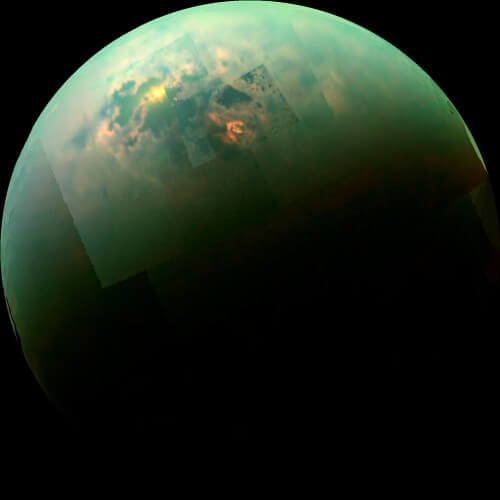"Bucket brigade" - a process in which activity is carried out from one place and its accumulation in a second place until the result is felt occurs on Titan and transfers liquid methane from Titan to the North Pole which is therefore full of lakes and seas

Researchers believe they have found the "bucket brigade" that is slowly but surely wetting the north pole of Saturn's moon Titan - the only world in the solar system, apart from Earth, that has lakes, seas and rainy weather.
A bucket brigade is a method of moving items in a human chain, for example clearing rubble following an earthquake, and by borrowing - a long process that is done in small steps over time and thus succeeds in achieving a big result.
For more than a decade, since the Huygens spacecraft that separated from Cassini landed on the ground on its way through the nebulous atmosphere, the region of excessive humidity in the north has been a puzzle for scientists.
Since Titan receives only about a percent of the sun's energy compared to Earth and the apparent average temperature is minus 180 degrees Celsius, the days and weather on Titan are made of liquid methane, which can only exist at these low temperatures. Titan's north polar region is full of methane lakes and seas. This is in contrast to Titan's south pole which has only one significant body of liquid near it. Since then, scientists have been trying to build models to predict the conditions that likely led to Titan's wet northern region.
"We've been looking at different aspects of Titan's climate in recent years," said Juan Laura of the University of California, Los Angeles. "We conducted various simulations to predict types of weather events in two dimensions and three dimensions. In the two-dimensional model, Titan's atmosphere did not produce a symmetrical distribution of the liquids, but we saw the asymmetry develop very quickly in three dimensions."
Scientists thought that the basic reason for the difference in the amount of liquid on the surface at the poles is the eccentric orbit of Saturn, and therefore also Titan around the Sun. This orbit produces a shorter, more intense summer in Titan's southern hemisphere and a longer, but less intense summer in the north. But how these data translate to more liquid on the ground in the north has not been explained.
In the new study, Laura and his colleagues used XNUMXD models of Titan and showed that methane, which evaporates rapidly from the equator of the Saturnian moon, flows slowly through the atmosphere from the south pole to the north pole. The model results are consistent with observations of Titan where the low latitudes are seen to be dry and the polar regions are wet. A lot of clouds were also seen moving around the South Pole during the summer there, Laura explained.
In particular, the XNUMXD model showed that methane drifts toward the equator from both poles in pulsations or eddies. These pulses create a kind of "bucket brigade" that is stronger in the south and therefore it transports more methane from this area towards the north.
"For thousands to tens of thousands of years, methane accumulates in the north," said Laura, the lead author of the new study. The result is the distorted state we see on Titan today, he said.
The study was published in the journal Geophysical Research Letters of the American Geophysical Union (AGU).

One response
In Hebrew: chain of buckets